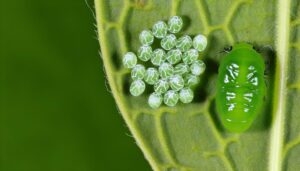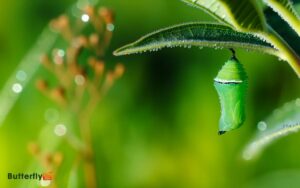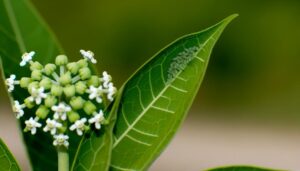Top 5 Flowers Monarch Butterflies Do Like
Monarch butterflies are prominently attracted to Asclepias species, commonly known as milkweed, which is vital for their larval development due to its high cardenolide content. During migration, they favor nectar-rich plants such as Butterfly Weed, Lantana, Zinnias, Purple Coneflower, and Joe-Pye Weed.
Other significant sources include Blazing Star, Verbena, and Mexican Sunflower. These plants provide a prolonged blooming period and high nectar yield necessary for energy accumulation.
Understanding these floral preferences is essential for conservation and habitat restoration efforts, and further exploration reveals interesting ecological interdependencies.
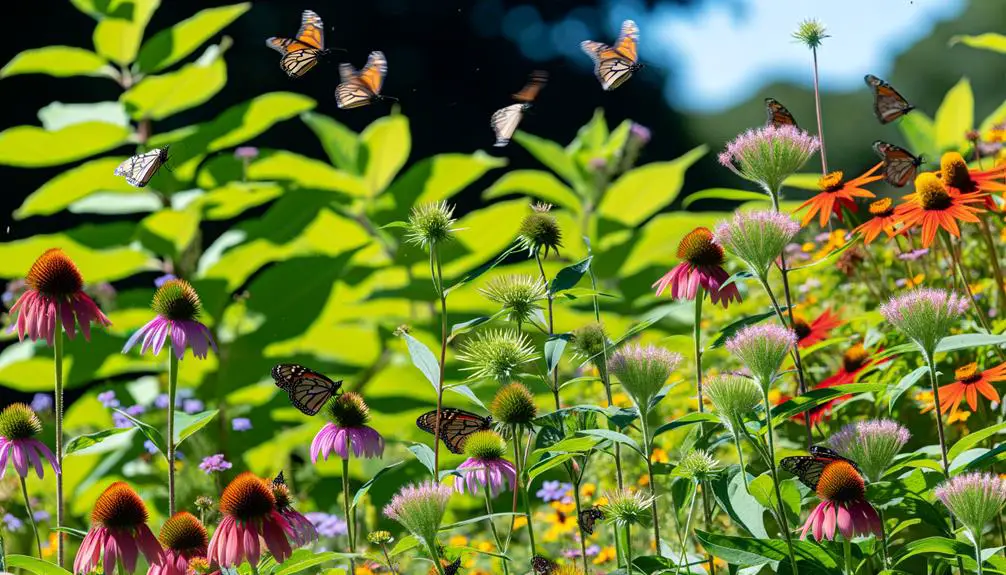
Key Takeaways
- Monarch butterflies like milkweed (Asclepias species) for larval development and adult nectar.
- Butterfly Weed and Lantana are critical nectar sources during migration with vibrant flowers and prolonged blooming periods.
- Zinnias provide abundant nectar and are easily accessible, blooming from spring to frost.
- Purple Coneflower and Black-Eyed Susan offer high nectar content and extended blooming seasons, supporting energy needs.
Milkweed

Milkweed, specifically from the genus Asclepias, serves as the primary host plant for Monarch butterflies, providing essential resources for their larval development.
Asclepias species produce cardenolides, toxic compounds that deter predators, consequently offering larvae a chemical defense mechanism. Monarch larvae exhibit a specialized adaptation to metabolize these compounds, integrating them into their own tissues. This biochemical interaction underscores the mutual dependency between Monarchs and milkweed.
Empirical studies indicate that Monarch oviposition is highly selective, favoring Asclepias species with high cardenolide concentrations. In addition, milkweed provides nectar for adult Monarchs, supporting their migratory energy requirements.
Conservation efforts emphasize planting native milkweed to mitigate habitat loss, thereby ensuring the continuity of this vital ecological relationship.
Butterfly Weed
Butterfly Weed (Asclepias tuberosa), a member of the milkweed family, is a critical nectar source for Monarch butterflies, particularly during their migration periods. This perennial plant is notable for its vibrant orange flowers and its ability to thrive in various soil types, making it highly adaptable.
Key attributes include:
- Nectar-Rich Blooms: Butterfly Weed provides ample nectar, essential for Monarchs' energy needs during long migrations.
- Drought Tolerance: Its deep taproot system allows it to endure dry conditions, supporting butterfly populations in arid regions.
- Low Maintenance: Requiring minimal care, Butterfly Weed is ideal for sustainable gardening practices.
Incorporating Butterfly Weed into gardens supports Monarch conservation efforts effectively.
Lantana
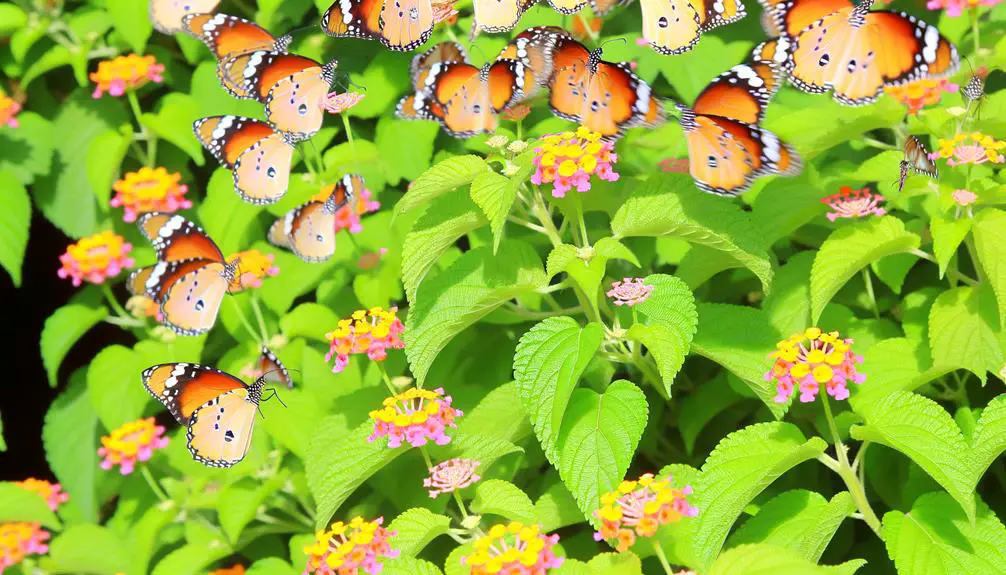
Lantana serves as a significant nectar source for Monarch butterflies, contributing to their sustenance during migration.
This species exhibits an extended blooming period, providing consistent floral resources across multiple seasons.
Additionally, Lantana's compatibility with various companion plants enhances biodiversity and ecological stability in butterfly habitats.
Nectar-Rich Floral Attraction
Known for its vibrant clusters of flowers, Lantana camara is highly favored by monarch butterflies due to its abundant nectar production. This species is a cornerstone in butterfly gardens, providing essential nourishment for migrating monarchs. The plant's high nectar yield, combined with its accessibility, makes it an ideal choice for sustaining butterfly populations.
Key attributes of Lantana camara include:
- Nectar-rich blooms: Ensuring a consistent food source for monarchs.
- Extended flowering period: Maximizing the availability of resources throughout key migration times.
- Brightly colored flowers: Attracting butterflies through visual cues.
These characteristics underscore Lantana camara's importance in ecological conservation efforts aimed at supporting monarch butterflies.
Seasonal Blooming Patterns
The extended flowering period of Lantana camara is essential in providing a reliable nectar source throughout the various stages of monarch butterfly migration. This perennial plant exhibits a protracted blooming phase, typically spanning from early spring to late autumn. Such a prolonged floral display guarantees that monarchs, which migrate over vast distances, have consistent access to important nourishment.
Studies have shown that Lantana camara's flowers produce a high quantity of nectar, which is rich in sugars necessary for the energy-intensive migratory journeys of monarch butterflies. Additionally, the plant's resilience to varying climatic conditions enhances its suitability as a dependable nectar source across different geographical regions.
Consequently, the seasonal blooming patterns of Lantana camara are significant for supporting monarch populations.
Companion Plant Benefits
Numerous studies have demonstrated that integrating *Lantana camara* with other flowering plants can enhance overall garden biodiversity and improve habitat quality for monarch butterflies. This practice not only bolsters the ecological network but also provides several specific benefits:
- Pest Control: Lantana's natural compounds can deter certain insect pests, reducing the need for chemical interventions.
- Pollinator Attraction: The vibrant colors and nectar of Lantana attract various pollinators, including bees and butterflies, increasing pollination success rates.
- Soil Health: Lantana contributes organic matter to the soil, enhancing its fertility and structure.
These advantages underscore Lantana's role in sustainable gardening practices.
Zinnias
Characterized by their vibrant colors and abundant nectar, zinnias serve as an essential food source for monarch butterflies. Native to Mexico, Zinnia spp. exhibit a high nectar yield, which is particularly attractive to monarchs during their migration.
Studies have demonstrated that zinnias provide a rich source of carbohydrates, vital for energy during long flights. These flowers bloom from spring to frost, ensuring a prolonged period of availability.
Additionally, the flat-topped structure of zinnia flowers facilitates easy access to nectar for monarchs. The diverse color palette, ranging from red to purple, further aids in attracting these insects.
Therefore, cultivating zinnias in gardens can greatly contribute to the sustenance and conservation of monarch butterfly populations.
Purple Coneflower
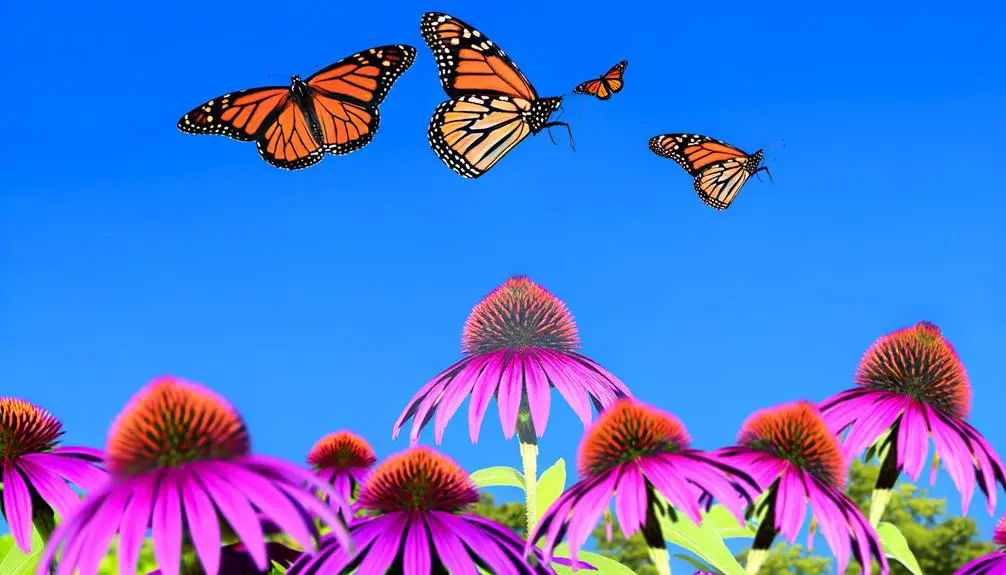
The Purple Coneflower (Echinacea purpurea) is highly favored by Monarch butterflies due to its abundant nectar-rich blooms.
Empirical studies have shown that its extended blooming season provides a consistent food source, vital for Monarch sustenance during migration periods.
This perennial's resilience and prolonged flowering period make it an essential component of butterfly-friendly habitats.
Nectar-Rich Blooms
Purple coneflowers (Echinacea purpurea) serve as an essential nectar source for monarch butterflies due to their high nectar content and prolonged blooming period.
These perennial plants are not only visually striking but also offer a reliable food source for migrating monarchs. The biochemical composition of their nectar provides an ideal balance of sugars, vital for sustaining the butterflies' energy levels. In addition, their large, daisy-like flower heads facilitate easy access to nectar.
- Nutritional Profile: High concentration of sucrose, glucose, and fructose.
- Pollinator Attraction: Strong ultraviolet patterns visible to butterflies.
- Habitat Preference: Thrives in well-drained soils with full sun exposure.
This makes purple coneflowers indispensable in butterfly-friendly gardens.
Long Blooming Season
Extending its value to monarch butterflies, Echinacea purpurea's long blooming season guarantees a continuous nectar supply throughout the growing period.
This perennial, commonly known as Purple Coneflower, typically blooms from early summer to fall, providing an extended period of sustenance.
Research indicates that a prolonged availability of nectar sources is essential for supporting monarch populations, especially during migration.
The Purple Coneflower's robust and hardy nature assures it thrives in a variety of soil conditions, making it a reliable component in butterfly gardens.
Additionally, its vibrant flowers not only attract monarchs but also support a diverse array of pollinators.
Consequently, planting Echinacea purpurea can greatly enhance habitat sustainability, promoting ecological balance and freedom for these important pollinators.
Black-Eyed Susan
Black-Eyed Susan (Rudbeckia hirta) serves as an important nectar source for monarch butterflies, offering both sustenance and habitat. This native North American flower blooms from June to October, providing a continuous nectar supply during vital periods of monarch migration. The bright yellow petals and dark central cone are not only visually striking but also attract butterflies through UV patterns discernible to their vision.
Key benefits of Black-Eyed Susan for monarch butterflies include:
- Extended Bloom Period: Guarantees availability of nectar throughout the butterfly's life cycle.
- High Nectar Production: Supports energy needs for long migratory journeys.
- Habitat Provision: Offers a resting place for butterflies during migration.
These attributes make Black-Eyed Susan indispensable for monarch conservation.
Cosmos

Cosmos (Cosmos bipinnatus) is a highly beneficial nectar source for monarch butterflies, particularly noted for its vibrant, daisy-like flowers and prolific blooming period.
These annual plants thrive in a wide range of soil types, providing an accessible and consistent food source throughout the growing season. The bright, open blooms of Cosmos facilitate easy nectar access for monarchs, thereby supporting their energy needs during migration and reproduction.
Scientific observations underscore the plant's role in enhancing pollinator biodiversity within garden ecosystems.
Additionally, Cosmos' low maintenance requirements and resilience to climatic variations make it an ideal choice for cultivating butterfly-friendly habitats.
Essentially, Cosmos serves as both an ecological asset and a visually appealing addition to butterfly gardens.
Joe-Pye Weed
Joe-Pye Weed (Eutrochium spp.) is highly effective in attracting Monarch butterflies due to its abundant nectar and vibrant flower clusters.
Typically blooming from mid-summer to early fall, this perennial thrives in moist, well-drained soils and full to partial sunlight.
Ideal cultivation practices include maintaining soil moisture and ensuring adequate space to accommodate its substantial height and spread.
Attracting Monarch Butterflies
The perennial herb *Eupatorium purpureum*, commonly known as Joe-Pye Weed, is an essential plant for attracting monarch butterflies due to its high nectar production and late-summer blooming period.
This plant provides a critical food source during the monarchs' migration, enhancing their survival and reproduction. Its ecological benefits stem from several key attributes:
- High nectar yield: Supports sustained feeding and energy accumulation for migration.
- Tall, sturdy stems: Offer ample landing space for butterflies.
- Adaptability: Thrives in a variety of soil conditions, promoting widespread cultivation.
Incorporating Joe-Pye Weed into butterfly habitats is a scientifically-backed strategy to bolster monarch populations and contribute to biodiversity conservation.
Blooming Season Details
*Eupatorium purpureum*, commonly known as Joe-Pye Weed, typically blooms from mid-summer to early fall, specifically from July to September.
This blooming period coincides with a critical phase in the monarch butterfly's migratory cycle. During this time, monarchs are preparing for or commencing their southward migration.
The availability of nectar from Joe-Pye Weed provides essential energy reserves, supporting their long-distance travel.
Evidence indicates that the presence of late-season nectar sources like Joe-Pye Weed can greatly enhance monarch survival rates during migration, underscoring its role in sustaining this endangered species.
Consequently, planting Joe-Pye Weed can directly benefit monarch conservation efforts.
Growing Conditions Tips
Successfully cultivating *Eupatorium purpureum* often requires an environment that replicates its natural habitat, characterized by moist, well-drained soils and partial to full sunlight. This perennial, commonly known as Joe-Pye Weed, thrives in conditions that support its robust growth and prolific blooming, which are essential for attracting monarch butterflies. Adherence to specific growing conditions enhances plant health and butterfly visitation rates.
- Soil Composition: Rich in organic matter to support nutrient uptake.
- Watering Regimen: Consistent moisture, avoiding waterlogged conditions to prevent root rot.
- Sunlight Exposure: Minimum of 4-6 hours of direct sunlight daily.
Implementing these guidelines promotes the successful cultivation of *Eupatorium purpureum*, benefiting both the gardener and the pollinator population.
Blazing Star
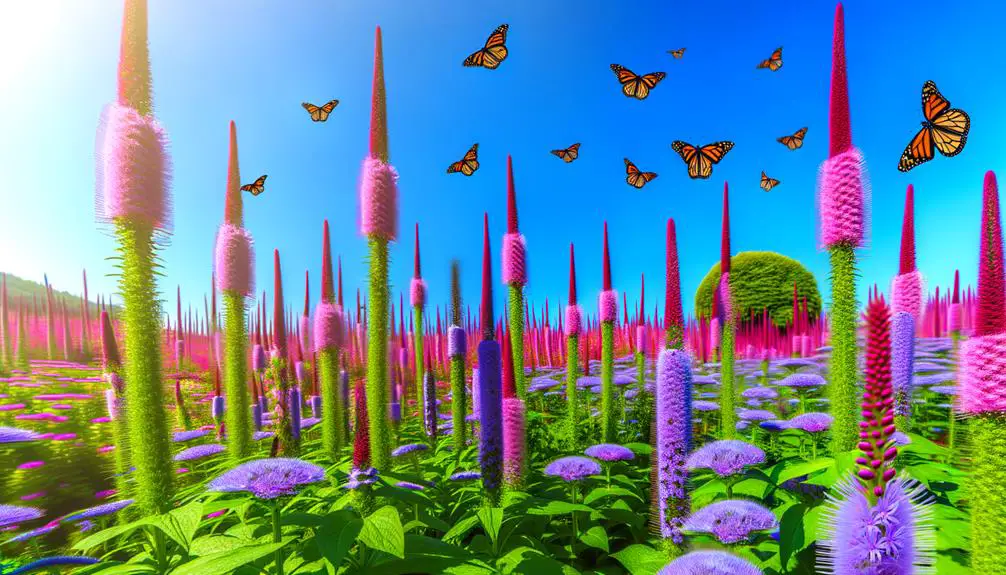
Blazing Star (Liatris spp.), a genus known for its vibrant purple spikes, serves as an essential nectar source for monarch butterflies during their migratory journey.
Liatris species exhibit inflorescences that are particularly attractive to monarchs due to their high nectar production and extended blooming period. Empirical studies have demonstrated that these flowers not only provide necessary energy reserves but also support pollinator biodiversity.
The perennial nature of Blazing Star, coupled with its adaptability to various soil types, makes it a resilient addition to butterfly gardens. Proper cultivation of Liatris spp. can markedly enhance habitat quality, offering critical sustenance for monarchs and contributing to their conservation amid declining population trends.
Consequently, integrating Blazing Star into landscapes promotes ecological freedom.
Verbena
Verbena (Verbena spp.) is a genus of flowering plants that provides an essential nectar source for monarch butterflies, particularly during their breeding season. These plants are highly valued for their ability to attract a variety of pollinators, including monarchs, due to their vibrant blooms and high nectar yield.
Key characteristics of Verbena include:
- Nectar-rich flowers: Important for sustaining monarchs during long migrations.
- Extended blooming period: Offers a reliable food source over several months.
- Adaptability: Thrives in various soil types and climatic conditions.
Incorporating Verbena into butterfly habitats can greatly enhance the survival and reproductive success of monarch butterflies.
Mexican Sunflower
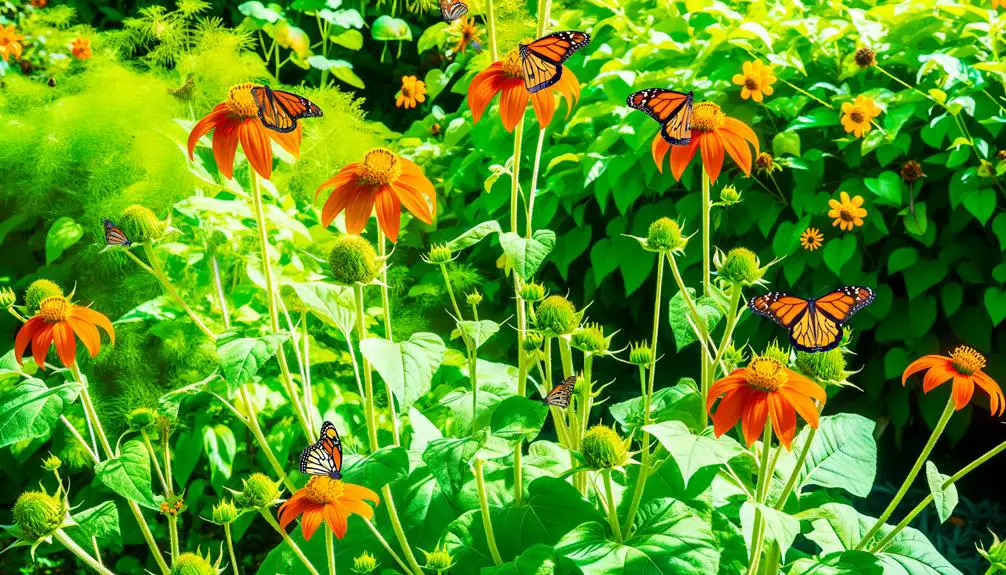
The Mexican sunflower (Tithonia rotundifolia) serves as an essential nectar source for monarch butterflies, particularly during their migratory periods. Characterized by its bright orange-red flowers, Tithonia rotundifolia provides high-energy nectar that supports the metabolic demands of monarchs.
Research indicates that these flowers bloom prolifically, offering sustained nourishment throughout the butterflies' long journeys. Additionally, the Mexican sunflower's tall, robust stems create an accessible feeding platform, enhancing nectar intake efficiency.
Studies have shown that incorporating Tithonia rotundifolia in butterfly gardens greatly boosts monarch visitation rates. For monarch conservationists and enthusiasts, cultivating this plant not only aids in sustaining the butterfly population but also contributes to a biodiverse ecosystem.
The adaptive significance of Tithonia rotundifolia underscores its value in ecological planning.
Conclusion
Monarch butterflies exhibit a marked preference for specific flora that provide both nectar and habitat essential for their lifecycle.
Significantly, milkweed serves as the primary host plant for monarch caterpillars. An interesting statistic highlights that over 90% of monarchs utilize milkweed species during their breeding season.
Additionally, adult monarchs frequently visit butterfly weed, lantana, zinnias, purple coneflower, Joe-Pye weed, blazing star, verbena, and Mexican sunflower for nectar.
These plants collectively support monarch populations through various stages of development and migration.


